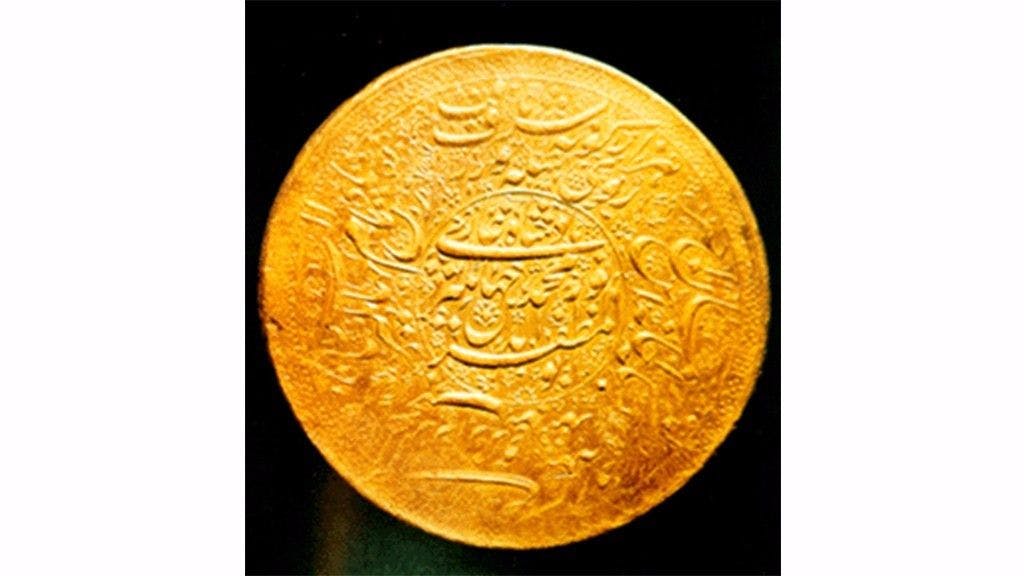India’s Largest Gold Coin
BOOKMARK
In the late 1980s the Indian Government was caught in a tizzy when it realised that a national treasure was being auctioned in Switzerland . The object in question was the largest known coin made of solid gold. Weighing 12 kgs, the mohar had been minted during the time of Mughal Emperor Jahangir. Records showed that the Emperor had given this 1000 mohar coin to the Persian Ambassador Zamil Baig. But it took time to figure how this massive chunk of history - had landed in an auction house.
The story of Jahangir’s Mohar made international headlines and it was ironic that the person who had put it up for sale was the bankrupt old feudatory of the Mughals the last Nizam of Hyderabad Mukkaram Jah.
The Mughals were well known for their wealth, opulence and grandeur. The emeralds, diamonds, thrones and jewels in their court was unsurpassed anywhere in the world. But this opulence at their height came because of economic prosperity and the empire they built. It is not surprising then that minting gold coins of large denominations was commonplace at the time of Jahangir and Shah Jahan. The Mughal mohars or gold coins came in a variety of denominations.
– Records showed that Jahangir had given this 1000 mohar coin to the Persian Ambassador Zamil Baig
During the reign of Jahangir, the coins grew larger high value mohars of 100, 200, 500 and even1000 where minted. While smaller mohars were used for daily transactions, the larger ones were handed out to to important officials who rendered special military services to the state. There are a few historic mentions of the 1000 mohar gold coin, including one in Jahangir’s own autobiography Tuzk-e-Jehangiri, where he writes that the coin was presented to the Persian ambassador Zamil Baig.
Beautifully crafted, this 12 kg coin is the largest gold coin ever made. It is about 21 cm in diameter and would have required great craftsmanship At the centre of the coin there is an inscription with the Emperors name and title and surrounding the circular core are two couplets most meticulously set on the coin. The couplet on the coin is worth mentioning:
Ba Hukm Shah Jahangir yaft sad zewer,
Banam Nur Jahan Badshah Begum zar
(By the order of Jahangir, gold attained a hundred times its beauty
When the name of Nur Jahan, the First Lady of the court was impressed upon it)
Till 1987, it was believed that none of these gigantic coins had survived and so when it came under the hammer in Switzerland, there was a fair bit of excitement.
As investigations were conducted the story of the coins journey came together.
– In the late 1980’s the Indian Government was caught in a tizzy when it realised that Jahangir’s gold mohar was being auctioned in Switzerland
According to historical records, one 1000 mohar gold coin was presented by Emperor Aurangzeb to Nawab Ghaziuddin Khan Siddiqui Bahadur, Feroze Jung I, whose son Nizam-ul-Mulk founded the Asaf Jah dynasty. For a little over two centuries, the coin passed from one generation to the next in the Nizam's family before coming into the possession of Mukarram Jah, the titular 8th Nizam. When the Indian consulate at Berne tried to intervene and stop the auction of the coin, Mukkaram Jah's lawyers argued that the law did not apply to antiquities taken out of India before 1947 and the coin had been taken to London by his mother, Princess Durrushehvar, before that date. A private sale went ahead and the coin was sold for a whopping 10 million dollars to an anonymous buyer.
Today, the Jahangir 1000 mohar coin as gone back into the vault and numismatic world is awaiting when it will be seen again.










